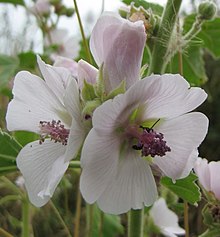Althaea (plant)
| Althaea | |
|---|---|
 |
|
| Marshmallow (Althaea officinalis) | |
| Scientific classification | |
| Kingdom: | Plantae |
| Clade: | Angiosperms |
| Clade: | Eudicots |
| Clade: | Rosids |
| Order: | Malvales |
| Family: | Malvaceae |
| Subfamily: | Malvoideae |
| Tribe: | Malveae |
| Genus: |
Althaea L. |
| Species | |
* Not accepted as distinct by all authors |
|
* Not accepted as distinct by all authors
Althaea is a genus of 6–12 species of perennial herbs native to Europe, North Africa and western Asia. It includes Althaea officinalis, also known as the marshmallow plant, whence the fluffy confection got its name. They are found on the banks of rivers and in salt marshes, preferring moist, sandy soils. The stems grow to 1–2 m tall, and flower in mid summer. The leaves are palmately lobed with 3–7 lobes. Althaea species are used as food plants by the larvae of some Lepidoptera species including Bucculatrix quadrigemina.
The genus formerly included a number of additional species now treated in the genus Alcea (hollyhocks).
The root contains starch (37%), mucilage (11%), pectin (11%), flavonoids, phenolic acids, sucrose, and asparagine.
The traditional medicinal uses of the plant are reflected in the name of the genus, which comes from the Greek althainein, meaning "to heal".
The flowers and young leaves can be eaten, and are often added to salads or are boiled and fried. The roots and stem also secrete mucilage, which is used to soften the skin, and is used in cosmetic treatments.
The Roman poet Horace refers to his own diet in his Odes, which he describes as very simple: "As for me, olives, endives, and smooth mallows provide sustenance."
...
Wikipedia
